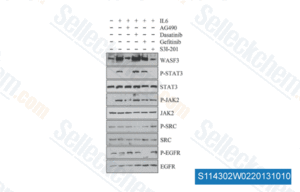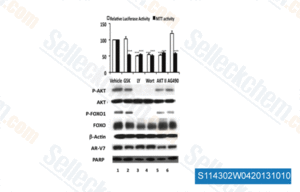|
Toll Free: (877) 796-6397 -- USA and Canada only -- |
Fax: +1-832-582-8590 Orders: +1-832-582-8158 |
Tech Support: +1-832-582-8158 Ext:3 Please provide your Order Number in the email. |
Technical Data
| Formula | C17H14N2O3 |
||||||
| Molecular Weight | 294.30 | CAS No. | 133550-30-8 | ||||
| Solubility (25°C)* | In vitro | DMSO | 58 mg/mL (197.07 mM) | ||||
| Ethanol | 6 mg/mL (20.38 mM) | ||||||
| Water | Insoluble | ||||||
| In vivo (Add solvents to the product individually and in order) |
|
||||||
|
* <1 mg/ml means slightly soluble or insoluble. * Please note that Selleck tests the solubility of all compounds in-house, and the actual solubility may differ slightly from published values. This is normal and is due to slight batch-to-batch variations. * Room temperature shipping (Stability testing shows this product can be shipped without any cooling measures.) |
|||||||
Preparing Stock Solutions
Biological Activity
| Description | AG-490 is an inhibitor of EGFR with IC50 of 0.1 μM in cell-free assays, 135-fold more selective for EGFR versus ErbB2, also inhibits JAK2 with no activity to Lck, Lyn, Btk, Syk and Src. | ||||
|---|---|---|---|---|---|
| Targets |
|
||||
| In vitro | AG-490 inhibits HER-2 driven cell proliferation with IC50 of 3.5 μM. [1] Corresponding to the specific dose-dependent inhibition of constitutively activated JAK2 in pre-B acute leukemia (ALL) cells, AG-490 (5 μM) almost completely blocks the growth of all ALL cells by inducing programmed cell death, with no deleterious effect on normal hematopoiesis. AG-490 does not inhibit the activities of Lck, Lyn, Btk, Syk, and Src. [2] AG-490 (60-100 μM) blocks the constitutive activation of Stat3sm, and inhibits spontaneous as well as interleukin 2-induced growth of mycosis fungoides (MF) tumor cells with IC50 values of 75 μM and 20 μM, respectively. [3] AG-490 potently inhibits IL-2-mediated human T cell growth with an IC50 of 25 μM by blocking the activities of JAK3 and STAT5a/b. [4] Although AG-490 alone has no effect on proliferation of FDrv210H cells at a concentration of 5 μM, AG-490 can synergize with STI571 to enhance its inhibitory effect on p210bcr-abl driven proliferation. [5] AG-490 significantly inhibits the constitutive activation of Stat3 in MOPC, MPC11, and S194 cells, leading to dramatic dose-dependent apoptosis. [6] AG-490 (100 μM) inhibits Akt phosphorylation, inhibits the activation of nuclear factor-κB, and causes the activation of GSK-3β, leading to the reduction of c-Myc. AG-490 (50 μM) can induce apoptosis of imatinib-resistant BaF3 cells expressing T315I and E255K mutants of Bcr-Abl. [7] AG-490 at 30 μM inhibits not only Epo-induced phosphorylation of wild-type JAK2 but also constitutive phosphorylation of the JAK2 V617F mutant. AG-490 also potently inhibits cytokine-independent cell growth induced by the JAK2 V617F mutant in BaF3 cells. [8] | ||||
| In vivo | Administration of AG-490 drastically reduces the numbers of CD45+ and HLA-DR+ cells from 48 % and 46% in bone marrow of untreated mice, as well as 38% and 22% in the spleen of untreated mice to undetectale levels. [2] In vivo administration of AG-490 causes murine myeloma tumor cell apoptosis but does not inhibit IL-12-mediated macrophage activation and IFN-γ production by lymphocytes. [6] Consistent with the in vitro blocking of JAK2 V617F mutant activity, AG-490 treatment at 0.5 mg/day for 10 days effectively inhibits JAK2 V617F mutant-induced tumorigenesis and tumor cell invasion in nude mice. [8] Combined therapy with AG-490 and IL-12 induces greater antitumor effects than either agent alone in a murine myeloma tumor model. [6] |
Protocol (from reference)
| Kinase Assay: |
|
|---|---|
| Cell Assay: |
|
| Animal Study: |
|
References
Customer Product Validation

-
Data from [Data independently produced by Carcinogenesis, 2013, 34, 1994-9]

-
Data from [Data independently produced by Carcinogenesis, 2013, 34, 1994-9]

-
Data from [Prostate, 2013, 73(3), 267-77]

-
Data from [Biochem Biophys Res Commun, 2013, 435(4), 533-9]
Selleck's AG-490 has been cited by 130 publications
| Phospholipid scramblase 1 is involved in immunogenic cell death and contributes to dendritic cell-based vaccine efficiency to elicit antitumor immune response in vitro [ Cytotherapy, 2024, 26(2):145-156] | PubMed: 38099895 |
| Kynurenic acid blunts A1 astrocyte activation against neurodegeneration in HIV-associated neurocognitive disorders [ J Neuroinflammation, 2023, 20(1):87] | PubMed: 36997969 |
| Syndecan-1 shedding destroys epithelial adherens junctions through STAT3 after renal ischemia/reperfusion injury [ iScience, 2023, 26(11):108211] | PubMed: 37942007 |
| Leptin Promotes the Proliferation and Neuronal Differentiation of Neural Stem Cells through the Cooperative Action of MAPK/ERK1/2, JAK2/STAT3 and PI3K/AKT Signaling Pathways [ Int J Mol Sci, 2023, 10.3390/ijms242015151] | PubMed: 37894835 |
| Induced expression modes of genes related to Toll, Imd, and JAK/STAT signaling pathway-mediated immune response in Spodoptera frugiperda infected with Beauveria bassiana [ Front Physiol, 2023, 14:1249662] | PubMed: 37693000 |
| Induced expression modes of genes related to Toll, Imd, and JAK/STAT signaling pathway-mediated immune response in Spodoptera frugiperda infected with Beauveria bassiana [ Front Physiol, 2023, 10.3389/fphys.2023.1249662] | PubMed: 37693000 |
| Vagus nerve stimulation protects against cerebral injury after cardiopulmonary resuscitation by inhibiting inflammation through the TLR4/NF-κB and α7nAChR/JAK2 signaling pathways [ World J Emerg Med, 2023, 10.5847/wjem.j.1920-8642.2023.102] | PubMed: 37969224 |
| PERK reprograms hematopoietic progenitor cells to direct tumor-promoting myelopoiesis in the spleen [ J Exp Med, 2022, 219(4)e20211498] | PubMed: 35266960 |
| Phosphorylation of PBK/TOPK Tyr74 by JAK2 promotes Burkitt lymphoma tumor growth [ Cancer Lett, 2022, 544:215812] | PubMed: 35780928 |
| Sphingosine-1 phosphate receptor 1 contributes to central sensitization in recurrent nitroglycerin-induced chronic migraine model [ J Headache Pain, 2022, 23(1):25] | PubMed: 35144528 |
RETURN POLICY
Selleck Chemical’s Unconditional Return Policy ensures a smooth online shopping experience for our customers. If you are in any way unsatisfied with your purchase, you may return any item(s) within 7 days of receiving it. In the event of product quality issues, either protocol related or product related problems, you may return any item(s) within 365 days from the original purchase date. Please follow the instructions below when returning products.
SHIPPING AND STORAGE
Selleck products are transported at room temperature. If you receive the product at room temperature, please rest assured, the Selleck Quality Inspection Department has conducted experiments to verify that the normal temperature placement of one month will not affect the biological activity of powder products. After collecting, please store the product according to the requirements described in the datasheet. Most Selleck products are stable under the recommended conditions.
NOT FOR HUMAN, VETERINARY DIAGNOSTIC OR THERAPEUTIC USE.
